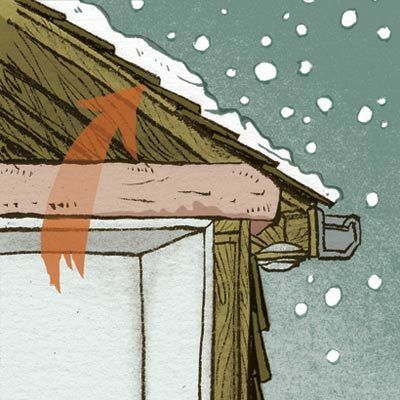Those Icicles Can Spell Trouble!
This unusually cold and snowy winter
has all the ingredients for disaster to develop
on the roof of your home!
Icicles hanging along the eaves of your house may look pretty, but they can cause lots of problems. Icicles can foreshadow the formation of ice dams along the eaves – thick ridges of solid ice that can tear off gutters, loosen roof shingles and cause water to back up and leak into the house.
Here’s how ice dams form. Snow collects on the roof. Ice accumulates along the eaves. If heat is escaping through the roof or if the sun is shining on the roof during the day, the ice begins to melt. Lower night temperatures re-freeze the ice into thick blocks in gutters and along the eaves.
What can be done to prevent or remove ice dams? Here are some tips:
1) Pull off snow on the roof with a long-handled aluminum roof rake while you stand safely on the ground. Take off at least the first four feet of snow from the edge of the roof toward the peak. If you have a flat roof, you made need to remove all the snow to prevent a roof collapse.
2) Be careful when attempting to remove ice dams with a hammer, chisel, or shovel. That can cause damage to the roof or gutter. Don’t throw salt on them either, as the salt can damage plantings below. Instead try this: Fill the leg of discarded pair of panty hose with a calcium chloride ice melt. Lay the hose onto the roof so it crosses the ice dam and overhangs the gutter. If necessary, use a long-handled garden rake or hoe to push it into position. The calcium chloride will eventually melt through the snow and ice and create a channel for water to flow down into the gutters or off the roof.
3) There are oversized “tablets” made of ice melt that can be tossed onto the roof to stimulate melting of snow and ice.
4) If you are already experiencing a leak in the roof, take a box fan into the attic and aim it at the underside of the roof where water is seeping in. This cold air will freeze the water in a manner of minutes.
Next winter, before the snow arrives, you can take the following precautions:
1) Equalize the roof temperature by attaching heated cables to the roof’s edge in a zigzag pattern.
2) Ventilate eaves and ridge. A ridge vent paired with continuous soffit vents circulates cold air under the entire roof. Both ridge and soffit vents should have the same size openings and provide at least one square foot of opening for every 300 square feet of attic floor. Place baffles at the eaves to maintain a clear path for the airflow from the soffit vents.
3) Be sure your attic hatch is sealed or your whole-house attic fan is covered with weather stripping to prevent heat from escaping from the attic.
4) Make certain that any ducts connected to kitchen, bathroom, and dryer vents lead outdoors through either the roof or walls … never through the soffit.
5) Add insulation to the attic floor which will keep the heat where it belongs – in the house and not escaping through the roof.
6) Check the flashing around the chimney and dormers. Be sure to use steel flashing held in place with unbroken beads of a fire-stop sealant. Don’t use canned spray foam – it isn’t safe!
7) Be sure that you have fiber-reinforced mastic on the joints of HVAC ducts and exhaust ducts. They should be covered with R-5 or R-6 foil-faced fiberglass.
8) Seal around electrical cables and vent pipes with a fire-stop sealant. Look for spots where light shines up from below or the insulation is stained black by the dirt from air flow.








